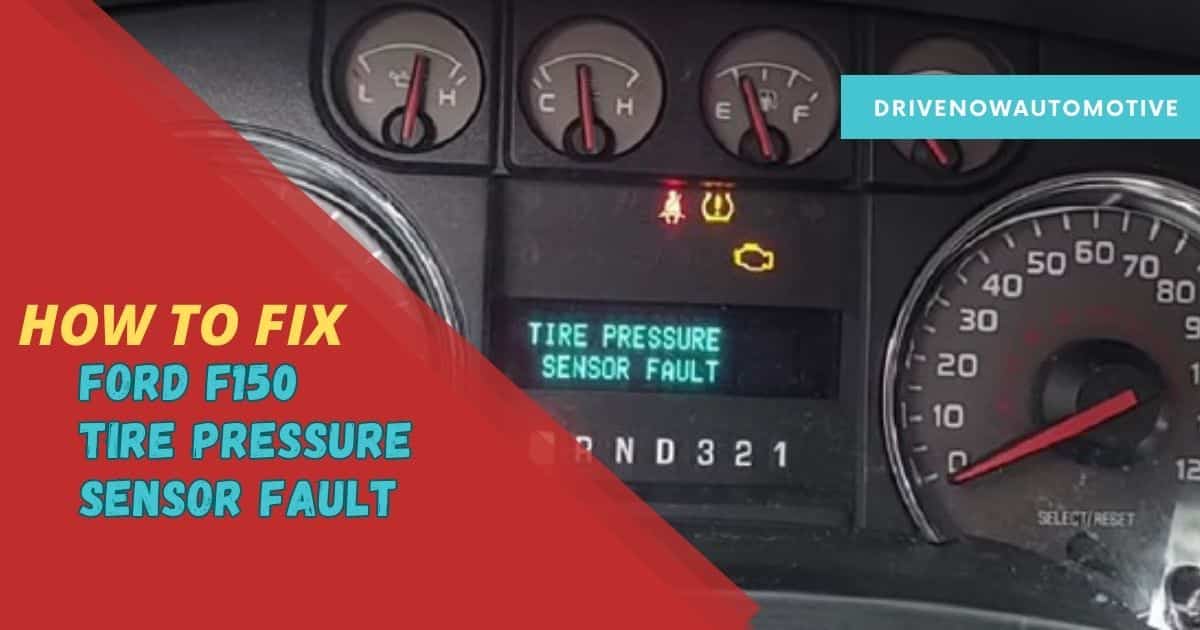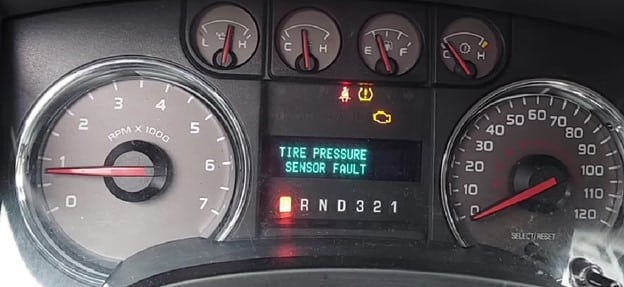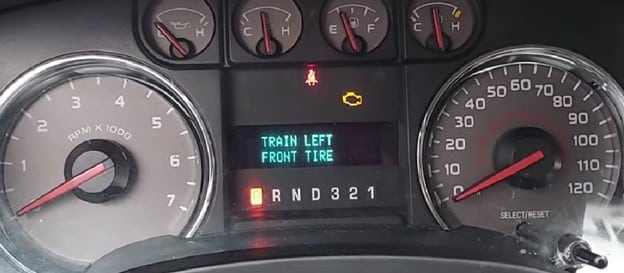To reset the tire pressure sensor fault message in F150, you need to put your TPMS into programming mode. Then, you can use a tool or let some air pressure out to reprogram the sensors. But if the sensors do not reset, then maybe its battery is dead, or the sensor is damaged. In that case, you can either replace the battery or replace the sensor itself.
From this article, you will have a detailed knowledge of resetting the tire pressure sensor fault in F150.
What Does the “Tire Pressure Sensor Fault” Message Mean?
The “Tire Pressure Sensor Fault” means that one or more of your tire pressure sensors are not working. In this case, you must determine faulty ones and take the necessary steps.
If you did not know, each tire has a pressure monitoring sensor, which is also called TPMS in short. These sensors are there to measure the air pressure and temperature inside the tires to prevent accidents due to under-inflated tires.

Causes Of Ford F-150 Tire Pressure Sensor Fault
TPMS Battery Failure:
TPMS sensors are powered by small coin batteries, which typically last between five and seven years. As the battery weakens, it may trigger intermittent TPMS warnings that come and go over time. Unfortunately, these batteries are sealed units, so replacing the sensor itself is often the only solution. It’s advisable to replace all four sensors simultaneously since they are likely to be of the same age.
Physical Damage:
The tire pressure sensors in your F-150 are positioned on the wheel assembly and are exposed to various external factors. Physical damage can occur when the sensors are hit by road debris, encounter potholes, or are involved in accidents. When these sensors sustain physical damage, it can disrupt their proper functionality, leading to a sensor fault. Therefore, it’s crucial to drive cautiously and avoid road hazards that could harm these sensors.
Temperature Changes:
Tire pressure is sensitive to temperature fluctuations. Extreme changes in temperature, such as those experienced during seasonal transitions, can impact tire pressure. For instance, in colder weather, the air inside the tires contracts, causing a drop in tire pressure. Conversely, in hot weather, the air expands, leading to increased pressure. The tire pressure sensors are designed to monitor these changes, but sometimes they may misinterpret a legitimate temperature-related pressure shift as a fault. To avoid this, it’s important to regularly check and adjust your tire pressure according to your vehicle’s specifications, especially during temperature swings.
Faulty Wiring or Connection:
The tire pressure sensors are connected to the vehicle’s computer system through wiring and connections. Any issues in these electrical connections, such as loose or damaged wires or corroded connectors, can disrupt the communication between the sensors and the vehicle’s computer. This disruption can result in false sensor readings and trigger a sensor fault. Routine inspection of the sensor connections can help identify and address wiring-related problems.
Tire Replacement:
When replacing one or more tires on your F-150, it’s essential to ensure that the new tires have functioning tire pressure sensors that are compatible with your vehicle. If the new tires lack sensors or have sensors that do not match your vehicle’s specifications, it can lead to sensor faults. Additionally, improper installation of the sensors during tire replacement can also cause issues. To prevent this, make sure that the replacement tires have the correct sensors, and that they are installed properly.
Signal Interference:
TPMS sensors operate on a low-frequency signal and can be susceptible to interference from various sources, including radar detectors, smartphones, aftermarket antennas, radios, and transceivers. Another common source of interference is old TPMS sensors that may be stored near your vehicle or in your garage. To address interference issues, dispose of old sensors and relocate spare wheels away from the vehicle. If you use interfering devices, consider discontinuing their use. After addressing interference, a TPMS reset may be necessary to clear the fault warning.
False TPMS Relearn:
When replacing TPMS sensors, a mechanic should use a scan tool to help the vehicle’s ECU relearn the new sensors. If this process fails or if old sensors are still in close proximity, it can lead to TPMS faults. In such cases, you may attempt a TPMS reset, but it’s important to ensure that old sensors are completely removed from the vicinity to prevent relearn issues.
These factors can contribute to a “Tire Pressure Sensor Fault” in your Ford F-150. For accurate diagnosis and resolution, consulting a qualified mechanic or dealership with access to specialized tools and equipment is recommended. Regular maintenance and addressing these issues promptly can help maintain the proper functioning of your TPMS.
How To Reset Ford F150 Tire Pressure Sensor Fault Message
A TPMS sensor can malfunction for a couple of reasons-
- It could have a dying or a dead battery.
- It may need to be reset (this applies every time you rotate your tires).
- Signal interference.
- It is damaged or worn out.
In any case, the initial process is more or less the same, which we will discuss below.

Method One: Reset Your Tire Pressure Sensor
How To Reset Your F150 Tire Pressure Sensor With A Tool
First, we will try to reprogram the TPMS sensors. Here is how;
To reset your TPMS, you need to set them in the programming mode first. The process of setting the programming mode is different for newer and older F150 models.
If you have a 2015 or newer F150 model, follow this process-
- Turn the ignition on without starting the car.
- Now, press the hazard button six times until the horn honks.
- You should see the “Train Left Front Tire” message on your display.
If you have a 2014 or older F150 model, follow the process below-
- Start the car without turning on the ignition.
- Press the brake pedal once and release it.
- Turn the ignition off and on and do it three times.
- Once again, step on the brake pedal and release it.
- Repeat step 3.
- The third cycle should trigger the vehicle’s horn to honk, and you should see the “Train Left Front Tire” message.

Now, your TPMS is ready to be reset. At this point, the process is the same for all F150 models, and you will need a Ford TPMS reset tool to progress.
- Take the tool, get down to the side of your left front tire, and press and hold the button on the tool for a few seconds.
- If the sensor on that tire is fine, you should hear one honk, and then you need to move on to the next tire.
- Follow the same process for the other three tires in this order- front right, rear right, and rear left.
If you hear a honk within a couple of seconds, then it means the sensors are fine and reset. But if you do not hear a honk or hear two honks instead, that means the sensor is bad.
If you need to reset your TPMS immediately, but you do not have the tool with you, no worries. This can be done even without any tools.
How To Reset Your F150 Tire Pressure Sensor Without A Tool
Instead of using the tool, use the tire valve cap to release some air pressure until you hear one honk. Do this for all the tires in the order we previously mentioned. Same as before, if you do not hear any honk after letting out a significant amount of air pressure or hear two honks, that sensor is bad.
If all the sensors respond accordingly, the reset process is complete. If you completed the reset procedure without the tool, inflate your tires to the proper amount after the procedure.
Method Two: Replace the Battery
Now, if your sensor is bad, there can be two possible reasons for this-
- The sensor’s battery is dead.
- The sensor itself is damaged.
If the battery is replenished, you need to put in a new battery for the sensor. But unless you are an expert in doing these sorts of things, it’s better to just hire someone to do that.
This is a relatively tough task because the sensor is in the rim of the wheel, so you will have to remove the tire from the rim to get access to the sensor.
The TPMS sensors use coin batteries, which are very cheap, around $5-$10, and the labor cost of replacing the battery could be around $50-$150.
Now, one thing to keep in mind is that the battery is often molded into the sensor. Although it would be cost-effective, it could prove to be challenging. So, some suggest that replacing the whole sensor is a better option.
But if you would still prefer to replace the battery and you would like to do it yourself, here is a video that may be useful-
Method Three: Replace the Sensors
Now, if you decide to just replace the faulty sensor, that would cost you a bit more, but you may get it done without any hassle.
Replacing the TPMS all by yourself can also be a pain, that’s because accessing the sensor is hard. So, it’s best to leave it to the professional. In that case, you may need around $260-$450 to replace all the sensors, including labor costs.
Unless you go for OEM sensors, the aftermarket ones are very cheap. You can get a set of four sensors for around $25-$30. On the other hand, the OEM sensors would cost you around $50 per set.
If you have the skill set to replace the sensors yourself, here is a video that may help you-
Can You Drive With a Tire Pressure Sensor Fault?
Yes, you can drive with a tire pressure sensor fault, but it is not recommended. TPMS is designed to keep you safe by alerting you of low tire pressure. If the TPMS is not working properly, you may not be aware of a low tire pressure situation. This can lead to a number of safety hazards.
Tips For Avoiding Tire Pressure Sensor Fault
If you are trying to avoid such hassle in the future, you can follow these steps-
- Check your tire pressure at least once a month or more often if you drive in hot or cold weather.
- Use a reliable tire pressure gauge. A cheap gauge can give inaccurate readings, which can lead to underinflated or overinflated tires.
- Have your TPMS system checked at least once a year or more often if you have had any problems with it in the past?
- Avoid driving over potholes and other obstacles. If you do hit a pothole, be sure to have your TPMS system checked.
- Wash your tires regularly to keep them clean. Dirt and debris can build up on the sensors in your TPMS system and interfere with their ability to send accurate readings.
- If you are storing your tires for an extended period of time, be sure to store them in a cool, dry place. Extreme temperatures can damage the sensors in your TPMS system.
Conclusion
Tire Pressure Sensor Fault in F150 does not seem like a serious issue, but if you neglect it, it can cause a serious accident. So, if you see this message, try to check up on your tires ASAP.
Last Updated on November 13, 2025 by Rifen
